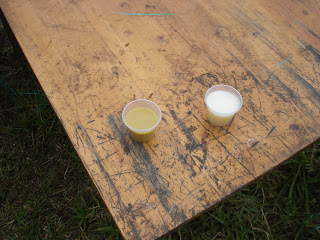
About a year ago, when my wife was still working on the ecotourism project in the Tenza Valley (I'm linking here to its snazzy finished website), we had the privilege of attending a seed fair set up by a local NGO that tries to promote local, ancestral crops in the region.
We stayed in the lovely El Encanto rural lodge, just outside of the town of Garagoa.

Upon entering the visitor is greeted by a number of traveler's palms. These are not actually palms but rather in the strelitzia family, like birds of paradise. Both are native to southern Africa, but have been spread throughout the tropics as ornamentals. I believe the traveler's palm got its name because it collects water in the leaf axils (like armpits, where the leaf stem meets the main stem), so a thirsty traveler can cut a branch and drink from it.


Another African resident of the hotel is a herd of guinea fowl. These are domestic birds that are eaten for meat. They are very territorial and protective, squawking and menacing whenever a potential threat shows up. This makes them good companions to stupid, defenseless chickens. We have our African forebears to thank for bringing this bird to the Americas.
Here is a smaller companion on the lodge grounds.

And here's a bird of paradise flower sheltered by elephant ears (neither are native to Colombia, though a variety of elephant ear has become a widespread domesticated staple for feeding pigs).

These are ginger flowers called "King's Scepter", also non-native, I'm pretty sure.

A comfortable house for the chicken flock.

Here is a specialized grill for making arepas. One arepa per little hole.


As in many mid-altitude tropical areas in Colombia, this farm is crisscrossed by small, rushing streams, with colorful bridges spanning them.

Here is a court for tejo, a classic central Colombian game. It's like horseshoes, except you throw a puck instead of a horseshoe, and the target is a metal ring in the center with a small envelope of gunpowder that explodes when you hit it.

Here is a view of the creek through a guadua bamboo grove.

The El Encanto lodge has communal areas and open cooking setups for holding big barbecues.


The goats keep the grass down.
 A banana grove.
A banana grove.
The pool

One of the independent cabins you can rent.



An evening snack of bread, cheese, and panela (molasses) water.

Not everything at the lodge is in great taste.

Anyway, aside from serving as an advertisement for the El Encanto lodge, the point of this post was to show the seed fair. The civic groups that organize these fairs set up a common theme for each one. This time the theme was corn, so everything on offer (for free!) at the fair was made from a corn base. There were cookies, fermented drinks, bread, toasted corn, arepas, and even dolls and clothing made from corn.





People from different towns and villages prepared typical dishes, and each locality had a stand with its name on a sign.

The fair took place on a rural schoolgrounds. The path leading to the place was bordered by old sisal bushes.

Who knows if they're still used to make fiber, or just cut back so they don't block the path? The school playground overlooks the amazingly beautiful landscape around the Chivor dam reservoir.

It appears that the international Slow Food movement somehow patronized the event, and there were lots of interesting informative panels to be looked at.



The above close-up makes the point that crops native to the Andean-Amazonian region (potatoes, cassava, beans, etc.) provide over a third of the world's food supply today.
A local authority from the indigenous movement made a dedication of the event, reciting prayers, singing, and offering chicha to the four directions and the earth.

After the seed fair (which this time didn't seem to have much seed exchanging going on), we passed through the main plaza of the town of Garagoa. It's not one of the more beautiful towns in the Tenza Valley, but the plaza is nice. It is home to a few massive ceiba trees. These trees are native to Africa and the Americas, and are considered sacred in both places. To this day many warm-climate towns in Colombia have hundred-year-old ceibas in their central plazas.

In the next photo you can see the scale of one of these trees compared to the sitting woman.
 The Garagoa plaza is also home to the flowery ocobo trees typical of the Tenza Valley.
The Garagoa plaza is also home to the flowery ocobo trees typical of the Tenza Valley.
There is also a relatively recent statue of Pachamama, the goddess of the earth. It's an indigenous legend, and there is a highland moor in the area called the Paramo of Pachamama, but the sculpture is very Euro-styled. Even the little mohans, local spirits that live in nature, look more like European elves or something. A good example of Colombia's unique mix of European and indigenous influences.

And here's a closing image showing another cultural mix, this time between the modern plastic jug and the ancestral clay pot, both holding chicha, fermented corn beer.

thanks for posting this. I have never looked at my town from the side you described it
ReplyDelete